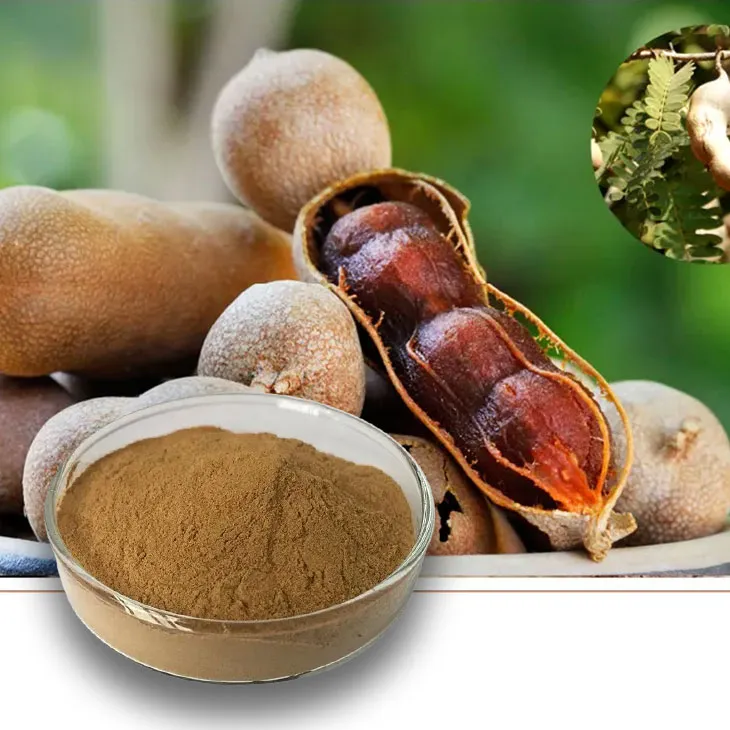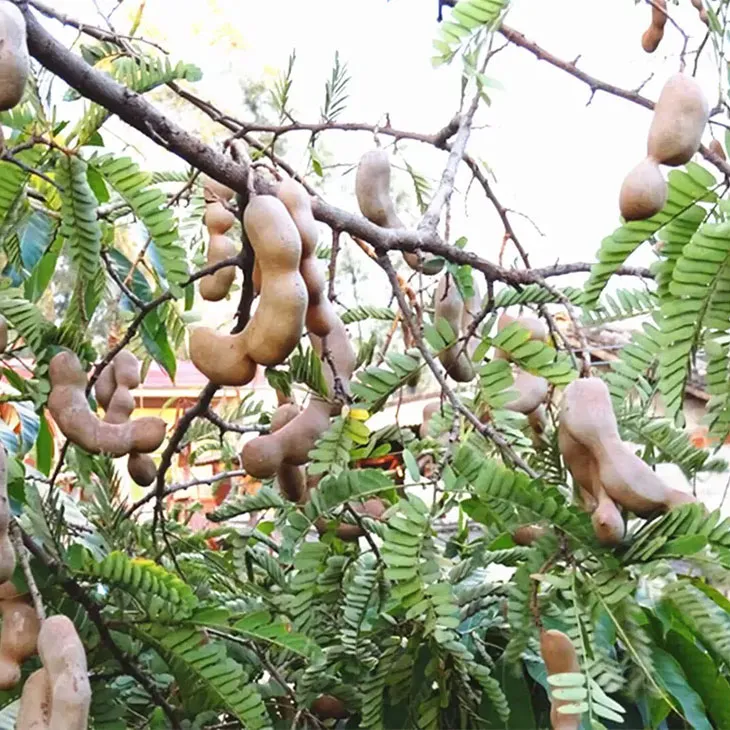- 0086-571-85302990
- sales@greenskybio.com
Chinese Tamarind Extract Powder Factory.
2024-11-28

1. Introduction
In the realm of natural extracts, China's Tamarind extract powder factories have emerged as significant players. Tamarind, a fruit known for its unique flavor and various beneficial properties, has become a valuable source of extract powder. These factories are not only contributing to the growth of the domestic natural extract industry but also making a mark on the international stage.

2. Location Advantage
One of the key factors contributing to the success of these factories is their strategic location. They are often situated in regions that are rich in tamarind resources. For example, some areas in southern China have a favorable climate for tamarind growth, which ensures a steady supply of raw materials.
This proximity to the source of raw materials has multiple advantages. It reduces transportation costs and time, which in turn helps in maintaining the freshness and quality of the tamarind fruits before extraction. Moreover, it also supports the local economy by promoting the cultivation and harvesting of tamarind in the surrounding areas.

3. Advanced Extraction Techniques
3.1 Solvent Extraction
The factories employ advanced extraction techniques, and one of the commonly used methods is solvent extraction. In this process, solvents are carefully selected based on their ability to dissolve the desired components from the tamarind pulp. Commonly used solvents are non - toxic and food - grade, ensuring that the final extract powder is safe for various applications.
The solvent extraction process involves several steps. First, the tamarind pulp is prepared by removing the outer shell and any impurities. Then, the pulp is soaked in the solvent for a specific period. During this time, the active compounds in the tamarind, such as tartaric acid and other beneficial substances, are dissolved into the solvent.
After the soaking, the mixture is filtered to separate the solvent - containing extract from the solid residue. The solvent is then evaporated under controlled conditions, leaving behind the Tamarind extract powder. This method is effective in obtaining a relatively high - yield of extract powder with a good concentration of active ingredients.
3.2 Supercritical Fluid Extraction
Another state - of - the - art extraction technique used by these factories is supercritical fluid extraction. This method utilizes supercritical fluids, which possess properties between those of a gas and a liquid. Carbon dioxide is a commonly used supercritical fluid in this process due to its non - toxicity, non - flammability, and ease of handling.
In supercritical fluid extraction, the tamarind pulp is placed in a high - pressure chamber along with the supercritical fluid. Under specific pressure and temperature conditions, the supercritical fluid penetrates the cellular structure of the tamarind and selectively extracts the desired compounds. The advantage of this method is that it can produce a highly pure extract powder with minimal residue of solvents or other unwanted substances.
Moreover, supercritical fluid extraction is a more environmentally friendly option compared to some traditional extraction methods. It also allows for better control over the extraction process, resulting in a more consistent quality of the final Tamarind extract powder.

4. Stringent Quality Control
Quality control is the cornerstone of these tamarind extract powder factories. Stringent measures are implemented at every stage of production, starting from raw material selection.
When it comes to raw material selection, only high - quality tamarind fruits are chosen. These fruits are inspected for their ripeness, size, and absence of any diseases or pests. Any sub - standard fruits are rejected to ensure that the starting material is of the best quality.
During the extraction process, strict monitoring of parameters such as temperature, pressure, and extraction time is carried out. This ensures that the extraction is carried out optimally and that the quality of the extract powder is not compromised. For example, if the temperature is too high during solvent extraction, it may lead to the degradation of some of the active ingredients in the tamarind.
After extraction, the tamarind extract powder undergoes comprehensive quality testing. This includes analysis of its chemical composition, purity, and microbial content. Tests are conducted using advanced analytical instruments such as high - performance liquid chromatography (HPLC) for chemical analysis and microbiological assays to check for the presence of harmful bacteria or fungi.
Finally, during final packaging, the tamarind extract powder is carefully packaged in appropriate containers to protect it from moisture, light, and other environmental factors. The packaging is also labeled clearly with all the necessary information such as product name, batch number, expiration date, and usage instructions.

5. Research and Development
These factories are not content with just producing tamarind extract powder; they are also actively involved in research and development (R & D). The R & D efforts are focused on exploring new applications of tamarind extract powder in different industries.
In the food industry, research is being carried out to find new ways to use tamarind extract powder as a natural flavor enhancer, preservative, or acidulant. For example, it can be used in the production of sauces, jams, and beverages to add a unique tart flavor. It also has the potential to replace some of the artificial preservatives currently used in the food industry due to its natural antimicrobial properties.
In the pharmaceutical industry, studies are being conducted to explore the medicinal properties of tamarind extract powder. It is known to contain compounds that may have antioxidant, anti - inflammatory, and anti - diabetic effects. Researchers are trying to isolate and purify these active compounds for potential use in the development of new drugs or dietary supplements.
In the cosmetic industry, tamarind extract powder is being investigated for its skin - friendly properties. It can be used in skincare products such as creams, lotions, and masks due to its moisturizing, exfoliating, and anti - aging potential. For example, the tartaric acid in tamarind extract powder can help in exfoliating dead skin cells, leaving the skin smoother and more radiant.
By investing in R & D, these factories are not only expanding the market for tamarind extract powder but also contributing to the overall development of these industries with natural and sustainable solutions.
6. Market Reach
The products of China's tamarind extract powder factories have a wide market reach. They are highly popular in the domestic market, where the demand for natural and healthy food ingredients, pharmaceutical products, and cosmetics is on the rise.
However, their influence extends far beyond the domestic borders. These factories are also exporting their products to numerous countries around the world. The international market is attracted to the high - quality tamarind extract powder produced in China. Countries in Asia, Europe, and North America are among the major importers of these products.
The export of tamarind extract powder contributes significantly to China's position as a leading provider of natural extract products. It not only earns foreign exchange but also promotes the international recognition of Chinese - made natural extract products.
7. Conclusion
China's tamarind extract powder factories are at the forefront of quality and innovation in the natural extract industry. With their strategic location, advanced extraction techniques, stringent quality control, and active research and development, they are producing high - quality tamarind extract powder that has a wide range of applications in various industries.
As the demand for natural products continues to grow both at home and abroad, these factories are well - positioned to further expand their production and market share. Their success also serves as an example for other natural extract producers, highlighting the importance of quality, innovation, and sustainable development in the industry.
FAQ:
What are the main extraction techniques used in Chinese Tamarind Extract Powder Factories?
Chinese Tamarind Extract Powder Factories mainly use advanced extraction techniques such as solvent extraction and supercritical fluid extraction. Solvent extraction involves using appropriate solvents to dissolve the active components from tamarind, and then separating the solvent to obtain the extract. Supercritical fluid extraction uses supercritical fluids with special properties to extract high - purity tamarind extract powder more efficiently.
How do these factories ensure the quality of tamarind extract powder?
Quality control is crucial in these factories. They have strict measures at every stage of production. Starting from the selection of raw materials, only high - quality tamarinds are chosen. During the extraction process, parameters are closely monitored to ensure the consistency and purity of the extract. In the subsequent purification and drying steps, quality checks are carried out continuously. And finally, during packaging, strict hygiene and quality - assurance procedures are followed to ensure the final product meets high - quality standards.
What new applications are being explored for tamarind extract powder in these factories?
These factories are actively exploring new applications in the food, pharmaceutical, and cosmetic industries. In the food industry, it could be used as a natural flavor enhancer or preservative. In the pharmaceutical field, it may have potential in drug formulation or as an ingredient with certain health - promoting properties. In the cosmetic industry, it might be used in skincare products for its antioxidant or moisturizing properties, for example.
Why are Chinese Tamarind Extract Powder Factories popular in the international market?
There are several reasons for their popularity in the international market. Firstly, they are located in regions with rich tamarind resources, which ensures a stable supply of raw materials. Secondly, the use of advanced extraction techniques results in high - quality products. Thirdly, strict quality control measures guarantee the consistency and purity of the tamarind extract powder. Moreover, continuous research and development efforts enable them to meet the diverse needs of international customers.
What role does location play for Chinese Tamarind Extract Powder Factories?
The strategic location of these factories in regions rich in tamarind resources is very important. It allows for easy access to fresh and high - quality tamarinds as raw materials. This proximity reduces transportation costs and time, ensuring that the raw materials can be processed quickly while still maintaining their freshness and quality. It also gives these factories an advantage in terms of cost - effectiveness and competitiveness in the market.
Related literature
- Advances in Tamarind Extract Production Techniques"
- "Quality Assurance in Natural Extract Factories: The Case of Tamarind"
- "Tamarind Extract Powder: New Frontiers in International Trade"
- ▶ Hesperidin
- ▶ Citrus Bioflavonoids
- ▶ Plant Extract
- ▶ lycopene
- ▶ Diosmin
- ▶ Grape seed extract
- ▶ Sea buckthorn Juice Powder
- ▶ Fruit Juice Powder
- ▶ Hops Extract
- ▶ Artichoke Extract
- ▶ Mushroom extract
- ▶ Astaxanthin
- ▶ Green Tea Extract
- ▶ Curcumin
- ▶ Horse Chestnut Extract
- ▶ Other Product
- ▶ Boswellia Serrata Extract
- ▶ Resveratrol
- ▶ Marigold Extract
- ▶ Grape Leaf Extract
- ▶ New Product
- ▶ Aminolevulinic acid
- ▶ Cranberry Extract
- ▶ Red Yeast Rice
- ▶ Red Wine Extract
-
Hedyotis Diffusa Extract
2024-11-28
-
Mangosteen extract powder
2024-11-28
-
Oat Straw Extract Powder
2024-11-28
-
Purple Sweet Potato Extract
2024-11-28
-
Boswellia Serrata Extract
2024-11-28
-
Honeysuckle Pollen
2024-11-28
-
Oyster Mushroom Extract Powder
2024-11-28
-
Konjac Powder
2024-11-28
-
Horse Chestnut Extract
2024-11-28
-
Eucommia Ulmoides Extract
2024-11-28





















